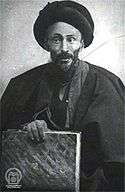Sayyid Jamal al-Din Va'iz
Sayyid Jamal al-Din "Va'iz" Esfahani (Persian: سید جمالالدین واعظ اصفهانی; also known as Seyed Jamal Vaez ["The Preacher"], 1862–1908) was a popular pro-constitutional preacher and writer in Iran. He was one of the founders of a constitutional movement in Isfahan in 1890s. He wrote for the reformist newspapers - especially for Al Jamal. He wrote mostly about the economy and the financial autonomy of Persia, which he compared it to jihad.

He is the father of Iranian writer Mohammad Ali Jamalzadeh.
Opponent to Shah o Qajar
Va'iz was an opponent to Mohammad-Ali Shah Qajar. "As to the ulama in the constitutional revolution, there were varying degrees of support for a constitution and of awareness of its implications. Among the popular preachers there were a number in the tradition of Afghani — men brought up with a religious education and filling, more than Afghani, religious functions, notably preaching, but who were not themselves believers in any usual sense. These included most notably two preacher friends from Isfahan — Malek al-Motakallemin[1] and Sayyed Jamal ad-Din Esfahani, the former the father of the historian of the constitutional revolution, Mehdi Malekzadeh, and the latter the father of Iran's first great modern short-story writer, Mohammad-Ali Jamalzadeh. Malek al-Motakallamin was long an Azali Bábí, although by the time he became a preacher in the revolution he appears to have lost even this belief, while Sayyed Jamal ad-Din Esfahani was described by his son as a freethinker. They both recognized the appeal of Islam to the masses and bazaaris, however. [...] In Tehran, the two became major preachers of the revolutionary and constitutional cause, explaining it in familiar Muslim terms emphasizing such Islamic concepts, particularly central in Shi'ism, as Justice and Oppression. Mohammad-Ali Shah considered them among the most dangerous of his enemies and had them both killed in 1908, as he did the editor of Sur-e Esrafil, Mirza Jahangir Khan, also of Bábí background."[2][3]
Publications
- Lebas ot taqva - against import of goods
- The True Dream with Majd al- Islam Kirmani (1872–1922)
See also
Bibliography
- Bayat, Mangol (1991). Iran's first revolution: Shi'ism and the constitutional revolution of 1905-1909. New York: Oxford University Press. ISBN 0-19-506822-X.
- Ansari, Sarah F. D.; Martin, Vanessa (2002). Women, religion and culture in Iran. Richmond, Surrey: Curzon in association with the Royal Asiatic Society of Great Britain and Ireland. p. 223. ISBN 0-7007-1509-6.
- Kian, A. The Secularisation of Iran (Travaux et memoires de l'Institut d'etudes iraniennes). Peeters Publishers. p. 55. ISBN 90-429-0032-6.
- Kashani-Sabet, Firoozeh (1999). Frontier fictions: shaping the Iranian nation, 1804-1946. Princeton, NJ: Princeton University Press. pp. 98, 255. ISBN 0-691-00497-8.
References
- Media:Malek al-Motakallemin.jpg
- Nikki R. Keddie, with a section by Yann Richard, Modern Iran - Roots and Results of Revolution, updated edition (Yale University Press, New Haven, 2003), pp. 179 and 180.
- "After an unsuccessful attempt on his [Mohammad-Ali Shah's] life, the shah achieved, following a failed coup, a successful coup d'état with the help of the Russian-led Cossack Brigade in June 1908. The majles was closed and many popular nationalist leaders, especially those of more advanced views, were arrested and executed. The radical preachers Jamal ad-Din Esfahani (caught while trying to flee), Malek al-Motakallemin and the editor of Sur-e Esrafil, Mirza Jahangir Khan (the last two had Azali Bábí ties), were among those killed. Taqizadeh along with some others found refuge in the BritishLegation, whence he went abroad for a time." Nikki R. Keddie, op. cit., p. 70.